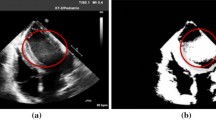Abstract
Echocardiography-based cardiac boundary tracking provides valuable information about the heart condition for interventional procedures and intensive care applications. Nevertheless, echocardiographic images come with several issues, making it a challenging task to develop a tracking and segmentation algorithm that is robust to shadows, occlusions, and heart rate changes. We propose an autonomous tracking method to improve the robustness and efficiency of echocardiographic tracking. A method denoted by hybrid Condensation and adaptive Kalman filter (HCAKF) is proposed to overcome tracking challenges of echocardiograms, such as variable heart rate and sensitivity to the initialization stage. The tracking process is initiated by utilizing active shape model, which provides the tracking methods with a number of tracking features. The procedure tracks the endocardium borders, and it is able to adapt to changes in the cardiac boundaries velocity and visibility. HCAKF enables one to use a much smaller number of samples that is used in Condensation without sacrificing tracking accuracy. Furthermore, despite combining the two methods, our complexity analysis shows that HCAKF can produce results in real-time. The obtained results demonstrate the robustness of the proposed method to the changes in the heart rate, yielding an Hausdorff distance of \(1.032\pm 0.375\) while providing adequate efficiency for real-time operations.





Similar content being viewed by others
References
Roth, G.A., et al.: Global, regional, and national age-sex-specific mortality for 282 causes of death in 195 countries and territories, 1980–2017: a systematic analysis for the global burden of disease study 2017 392(10159), 1736–1788 (2018)
Hatt, C.R., et al.: Mri 3d ultrasound x-ray image fusion with electromagnetic tracking for transendocardial therapeutic injections: in-vitro validation and in-vivo feasibility. Comput. Med. Imaging Graph. 37(2), 162–173 (2013)
Belaid, A., Boukerroui, D.: Local maximum likelihood segmentation of echocardiographic images with rayleigh distribution. SIViP 12(6), 1087–1096 (2018)
Pratiwi, A.A., et al.: Improved ejection fraction measurement on cardiac image using optical flow. In: 2017 International Electronics Symposium on Knowledge Creation and Intelligent Computing (IES-KCIC), pp. 295–300. IEEE (2017)
Joos, P., et al.: High-frame-rate speckle-tracking echocardiography. IEEE Trans. Ultrason. Ferroelectr. Freq. Control 65(5), 720–728 (2018)
Papangelopoulou, K., et al.: High frame rate speckle tracking echocardiography to assess diastolic function. Eur. Heart J. 42(Supplement–1), 724-ehab031 (2021)
Pedrosa, J., et al.: Fast and fully automatic left ventricular segmentation and tracking in echocardiography using shape-based b-spline explicit active surfaces. IEEE Trans. Med. Imaging 36(11), 2287–2296 (2017)
Blake, A., Curwen, R., Zisserman, A.: A framework for spatiotemporal control in the tracking of visual contours. Int. J. Comput. Vis. 11(2), 127–145 (1993)
Jacob, G., et al.: A shape-space-based approach to tracking myocardial borders and quantifying regional left-ventricular function applied in echocardiography. IEEE Trans. Med. Imaging 21(3), 226–238 (2002)
Isard, M., Blake, A.: Condensation conditional density propagation for visual tracking. Int. J. Comput. Vis. 29(1), 5–28 (1998)
Bernier, M., et al.: Graph cut-based method for segmenting the left ventricle from mri or echocardiographic images. Comput. Med. Imaging Graph. 58, 1–12 (2017)
Ficocelli, M., Janabi-Sharifi, F.: Adaptive filtering for pose estimation in visual servoing. In: Proc. 2001 IEEE/RSJ International Conference on Intelligent Robots and Systems. Expanding the Societal Role of Robotics in the the Next Millennium (Cat. No. 01CH37180), vol. 1, pp. 19–24. IEEE, Maui, USA (2001)
Ouyang, D., et al.: Video-based ai for beat-to-beat assessment of cardiac function. Nature 580(7802), 252–256 (2020)
Leclerc, S., et al.: Deep learning for segmentation using an open large-scale dataset in 2d echocardiography. IEEE Trans. Med. Imaging 38(9), 2198–2210 (2019)
Ali, Y., Janabi-Sharifi, F., Beheshti, S.: Echocardiographic image segmentation using deep res-u network. Biomed. Signal Process. Control 64, 102248 (2021)
Funding
The funding was provided by Natural Sciences and Engineering Research Council of Canada (Grant No. 2017–06930).
Author information
Authors and Affiliations
Corresponding author
Additional information
Publisher's Note
Springer Nature remains neutral with regard to jurisdictional claims in published maps and institutional affiliations.
Rights and permissions
About this article
Cite this article
Ali, Y., Beheshti, S., Janabi-Sharifi, F. et al. A hybrid approach for tracking borders in echocardiograms. SIViP 17, 453–461 (2023). https://doi.org/10.1007/s11760-022-02250-y
Received:
Revised:
Accepted:
Published:
Issue Date:
DOI: https://doi.org/10.1007/s11760-022-02250-y




